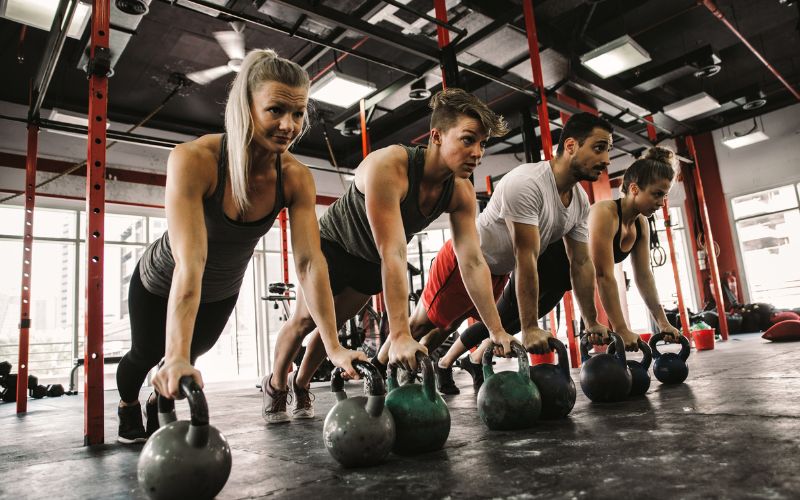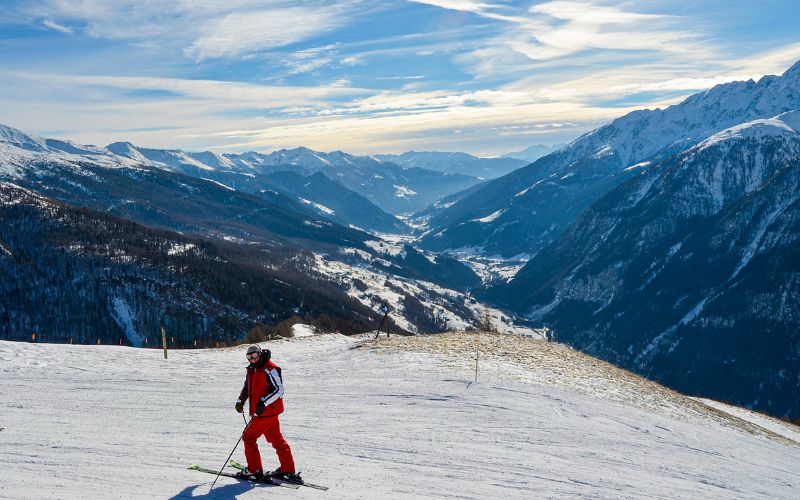
Functional Fitness for Winter: Super Activities to Boost Daily Performance 2023
Functional Fitness – Winter often comes with a desire to stay warm and cozy indoors, but it’s also a perfect time to focus on enhancing your functional fitness. Functional fitness is all about improving your physical abilities for everyday activities, making them easier and more efficient. In this comprehensive guide, we’ll explore a variety of winter activities that not only keep you active but also enhance your functional fitness, ensuring you stay in peak condition throughout the colder months.

Table of Contents
The Benefits of Functional Fitness
Functional Fitness: A Key to Daily Performance
Functional fitness isn’t just another fitness trend; it’s a holistic approach to health and well-being. It revolves around exercises and movements that mimic real-life activities, emphasizing functionality over aesthetics. While looking good is a desirable outcome, the true essence of functional fitness lies in its practicality. It’s about being able to perform daily tasks with ease, reducing the risk of injury, and enhancing overall physical competence.
In our increasingly sedentary world, where we spend hours hunched over screens and seated at desks, functional fitness takes on added importance. It’s a counterbalance to our modern lifestyles, promoting functional strength, flexibility, and mobility to ensure that we remain capable and resilient in the face of life’s physical demands.

Functional fitness recognizes that the body is a complex, interconnected system, and its exercises reflect this understanding. It targets multiple muscle groups simultaneously, emphasizing core stability and balance. Whether you’re reaching for an item on a high shelf, lifting a heavy object, or simply navigating uneven terrain, functional fitness equips you with the physical prowess to handle these tasks with ease.
Why Functional Fitness in Winter?
Winter introduces its own set of challenges, from snow-covered sidewalks to icy roads. It’s a season that demands agility, strength, and endurance. Engaging in functional fitness activities during the colder months can prepare your body for these challenges and improve your overall quality of life.
As the days grow shorter and the temperatures drop, the allure of hibernation indoors is strong. However, maintaining and even enhancing your functional fitness in winter has numerous advantages:

- Reduced Risk of Injury: Winter conditions can be treacherous, with slippery surfaces and heavy snow. Functional fitness can significantly improve your balance and stability, reducing the risk of slips and falls.
- Enhanced Daily Performance: From carrying groceries to climbing stairs, winter involves various physical tasks. Functional fitness readies you for these activities, making them feel more manageable and less strenuous.
- Increased Energy: Staying active in winter can help combat the lethargy that often accompanies the cold season. Regular exercise, even in colder temperatures, can boost your energy levels and improve your mood.
- Stress Reduction: Winter can be stressful, but exercise, especially in natural settings like snowy trails, can have a calming and mood-lifting effect. Functional fitness activities provide an opportunity to connect with nature and de-stress.
- Overall Well-Being: Engaging in functional fitness helps you maintain overall physical and mental well-being. It supports joint health, flexibility, and muscle strength while providing a sense of accomplishment.
In this article, we’ll explore a variety of functional fitness activities tailored to winter, ensuring that you not only stay active but also thrive during the chillier months. These activities offer a fun and practical way to boost your daily performance and embrace the beauty of winter while staying in tip-top shape. So, let’s dive into the world of functional fitness for winter and discover how you can make this season your healthiest and most active yet.
Winter Sports: Embrace the Chill
Skiing: Balance and Coordination
Skiing for Functional Fitness:
Skiing is not just a thrilling winter sport; it’s also an excellent way to work on your balance and coordination. The uneven terrain and need for precise movements engage your core and leg muscles, enhancing your stability and agility for daily tasks.
Balance Improvement: Skiing challenges your balance as you navigate slopes and maintain control. This translates to better stability when walking on slippery winter surfaces or when performing activities that require balance, like standing on one leg.
Coordination Enhancement: Skiing involves a complex interplay of movements. Your legs work independently as you turn, and your upper body assists in maintaining your posture. This coordination between upper and lower body can improve your ability to multitask and perform daily activities more efficiently.

Leg Strength: Skiing engages your leg muscles, including quadriceps, hamstrings, and calves, which are vital for activities like climbing stairs, getting in and out of a car, or standing up from a seated position.
Core Activation: Skiing requires a stable core to maintain balance and control. A strong core supports your spine and can reduce the risk of back pain, enhancing your ability to lift objects and perform twisting movements.
Cardiovascular Fitness: Skiing provides an excellent cardiovascular workout, improving your heart and lung health. This can lead to increased endurance, making it easier to tackle activities that demand sustained effort.
Skiing, whether you’re a novice or an experienced skier, offers a fun and effective way to enhance your functional fitness. It not only keeps you active during the winter but also equips you with the physical skills necessary to conquer daily tasks with confidence. So, hit the slopes and enjoy the benefits of improved balance, coordination, strength, and cardiovascular fitness that skiing brings to your winter season.
Ice Skating: Lower Body Strength
Ice Skating for Functional Fitness:
Ice skating is not just a delightful winter pastime; it’s also a fantastic way to enhance your functional fitness, particularly in terms of balance and lower body strength.
Balance Improvement: Ice skating challenges your balance as you glide gracefully on the ice. Maintaining equilibrium on the slippery surface requires continuous adjustments, which can significantly enhance your overall balance.
Lower Body Strength: Gliding on ice necessitates strong lower body muscles, particularly in the legs and glutes. The continuous leg movements for propulsion and stability help to tone and strengthen these muscle groups.
Ankle Stability: Ice skating demands precise control of your ankle movements. Over time, this can improve ankle stability, reducing the risk of sprains and enhancing your ability to walk on uneven winter surfaces.
Coordination: Coordinating your leg movements while maintaining balance is a fundamental skill in ice skating. This improved coordination can translate into better motor skills for daily activities.
Cardiovascular Fitness: Ice skating provides an excellent cardiovascular workout. Skating at a moderate to brisk pace elevates your heart rate, improving your cardiovascular health and overall endurance.
Whether you’re twirling gracefully on a frozen pond or skating laps at a local rink, ice skating offers a fun and enjoyable way to enhance your functional fitness during the winter season. It not only keeps you active but also hones your balance, strengthens your legs, and boosts your cardiovascular health, making you better prepared to tackle daily tasks in winter’s challenging conditions. So, lace up those skates and embrace the fitness benefits of gliding on ice.
Cross-Country Skiing: Cardio and Endurance
Cross-Country Skiing for Functional Fitness:
Cross-country skiing is more than just a scenic winter activity; it’s a full-body workout that enhances your functional fitness in multiple ways.
Cardiovascular Fitness: Cross-country skiing is renowned for its cardiovascular benefits. It’s an excellent aerobic exercise that elevates your heart rate, improving your cardiovascular health and overall endurance. This enhanced endurance can make it easier to tackle everyday tasks without feeling fatigued.
Full-Body Engagement: Unlike some winter sports that primarily work specific muscle groups, cross-country skiing engages your entire body. The rhythmic motion of skiing works your legs, arms, and core simultaneously. This comprehensive workout helps build overall strength, making daily activities more manageable.
Balance and Coordination: Navigating varied terrain while skiing requires constant adjustments and coordination. This enhances your sense of balance and improves your ability to move gracefully, reducing the risk of falls during everyday tasks.
Joint Health: The low-impact nature of cross-country skiing is gentle on your joints, making it an ideal choice for those looking to protect their knees and hips. Strong, well-conditioned joints are essential for maintaining mobility and ensuring everyday comfort.
Mental Well-Being: Skiing in serene, snow-covered landscapes can be a powerful mood booster. It provides an opportunity to connect with nature and escape the stresses of daily life, promoting mental well-being and reducing stress levels.
Cross-country skiing offers a unique blend of cardiovascular conditioning, muscle engagement, and mental rejuvenation, all while immersing you in the tranquil beauty of winter. Whether you’re gliding through groomed trails or exploring the backcountry, this winter activity is a fantastic way to boost your functional fitness and prepare your body for the challenges of the season. So, strap on those skis and embark on a journey to improved health and vitality through cross-country skiing.
Functional Workouts: Indoors and Out
Snow Shoveling: Full-Body Workout
Snow Shoveling for Functional Fitness:
Snow shoveling is not just a chore; it’s a fantastic full-body workout that can significantly enhance your functional fitness.

Full-Body Engagement: When you shovel snow, you engage your legs, core, and upper body muscles. This comprehensive workout helps improve overall strength, making daily activities like lifting, carrying, and bending easier.
Cardiovascular Exercise: Shoveling snow can elevate your heart rate, providing an effective cardiovascular workout. This helps improve your endurance and stamina for sustained physical tasks.
Balance and Stability: Navigating uneven terrain and handling the weight of snow on your shovel require balance and stability. Regular shoveling can enhance these skills, reducing the risk of slips and falls on icy surfaces.
Core Strength: A strong core is essential for maintaining good posture and preventing back pain. Snow shoveling engages your core muscles, helping you develop a stable and well-supported spine.
Functional Movements: The movements involved in shoveling snow mimic real-life activities such as lifting, twisting, and carrying. These functional movements translate directly to improved performance in everyday tasks.
Calorie Burn: Shoveling snow burns a significant number of calories. This can help with weight management and overall fitness, especially during the winter months when outdoor exercise opportunities may be limited.
It’s important to approach snow shoveling with proper technique to minimize the risk of injury. Bend your knees, lift with your legs, and avoid twisting your spine excessively. Also, be mindful of your body’s limits and take breaks as needed.
Snow shoveling isn’t just about clearing your driveway; it’s an opportunity to work on your functional fitness, preparing your body for the physical demands of winter. So, the next time you grab that shovel, think of it as more than a chore—it’s a chance to boost your strength, cardiovascular health, and overall well-being while conquering winter’s challenges.
Winter Hiking: Balance and Endurance
Winter Hiking for Functional Fitness:
Winter hiking is not only an excellent way to enjoy the serene beauty of snowy landscapes but also a fantastic activity to enhance your functional fitness.
Lower Body Strength: Hiking through snow-covered trails challenges your leg muscles, particularly your quadriceps and calves. The resistance of the snow builds lower body strength, which is essential for tasks like climbing stairs or carrying heavy loads.
Balance and Stability: Navigating uneven terrain and potentially slippery surfaces enhances your balance and stability. This can reduce the risk of slips and falls in everyday life, especially during icy conditions.
Cardiovascular Endurance: Winter hiking can provide a substantial cardiovascular workout. The combination of cold air and uphill climbs can elevate your heart rate, improving your endurance and overall cardiovascular health.
Core Engagement: Maintaining good posture and balance while hiking requires strong core muscles. A robust core is essential for everyday activities, as it supports your spine and reduces the risk of back pain.
Mental Well-Being: Connecting with nature and enjoying the tranquility of a snowy forest or mountain trail can have a profound impact on your mental well-being. It reduces stress and provides a sense of rejuvenation.
Joint Flexibility: Hiking in varied terrain requires a range of joint movements, promoting joint flexibility. This can contribute to better mobility and comfort in daily life.
When embarking on a winter hike, be sure to wear appropriate clothing and footwear for cold conditions. Additionally, check the trail conditions, and inform someone about your plans for safety. Winter hiking not only keeps you active but also strengthens your body and refreshes your mind, making it an ideal activity for enhancing your functional fitness during the winter season. So, put on your warm gear, grab your hiking boots, and experience the numerous benefits that winter hiking has to offer.
Functional Strength Training: Home Workouts
Functional Strength Training for Functional Fitness:
Functional strength training is a cornerstone of enhancing your functional fitness, and it’s particularly beneficial during the winter season.
Targeted Muscle Groups: Functional strength training focuses on specific muscle groups that play a crucial role in everyday movements. This includes the muscles in your legs, core, back, and shoulders, which are essential for lifting, bending, and carrying.
Improved Stability: Many functional strength exercises involve stability and balance, making them perfect for preparing your body for winter’s slippery conditions.
Functional Movements: The exercises used in functional strength training mirror real-life movements, such as squatting, pushing, pulling, and twisting. These movements directly translate to improved performance in daily tasks.
Injury Prevention: Strengthening the muscles that support your joints can reduce the risk of injury during winter activities and everyday movements.
Flexibility and Mobility: Functional strength training often includes exercises that enhance flexibility and mobility, making it easier to move comfortably in cold weather and navigate uneven terrain.
Customizable Workouts: Functional strength training allows you to tailor your workouts to target specific areas of weakness or areas that need improvement. This customization can help you address your unique functional fitness needs.
Functional strength training exercises can be performed both indoors and outdoors, making them versatile and suitable for all weather conditions. Incorporating these exercises into your winter routine will not only prepare you for the challenges of the season but also contribute to your overall well-being and fitness.
Indoor Activities: Stay Active When It’s Cold
Yoga: Flexibility and Balance
Yoga for Functional Fitness:
Yoga improves flexibility and balance, which are essential for daily activities. It also helps reduce stress and promotes relaxation, enhancing your overall well-being during the winter months.
Dance: Coordination and Cardio
Dance for Functional Fitness:
Dancing is a fun way to improve coordination and cardiovascular fitness. Whether you’re taking a dance class or dancing around your living room, it’s an enjoyable way to stay active indoors.
Indoor Climbing: Upper Body Strength
Indoor Climbing for Functional Fitness:
Indoor climbing challenges your upper body strength, grip, and problem-solving skills. It’s a great way to improve your ability to reach and grasp objects in daily life.
Conclusion – Functional Fitness
Winter doesn’t have to be a season of hibernation. By embracing functional fitness activities, you can boost your daily performance and stay active even in the chilliest months. Whether you choose winter sports, functional workouts, or indoor activities, the benefits of functional fitness extend beyond the winter season, ensuring you’re ready for whatever daily life throws your way. So, gear up, stay active, and make this winter a season of improved functional fitness. Your body will thank you, and you’ll be better prepared to tackle any winter challenge that comes your way.
You might also like:
Popular Stories
Newsletter
About me
Meet Dennis, an enthusiast of the great outdoors. For the past 15 years, he’s maintained a daily routine that includes running, hiking, and hitting the gym, embodying a commitment to an active and healthy lifestyle.
Dennis is a true advocate for the joy and rejuvenation that outdoor living can bring.



